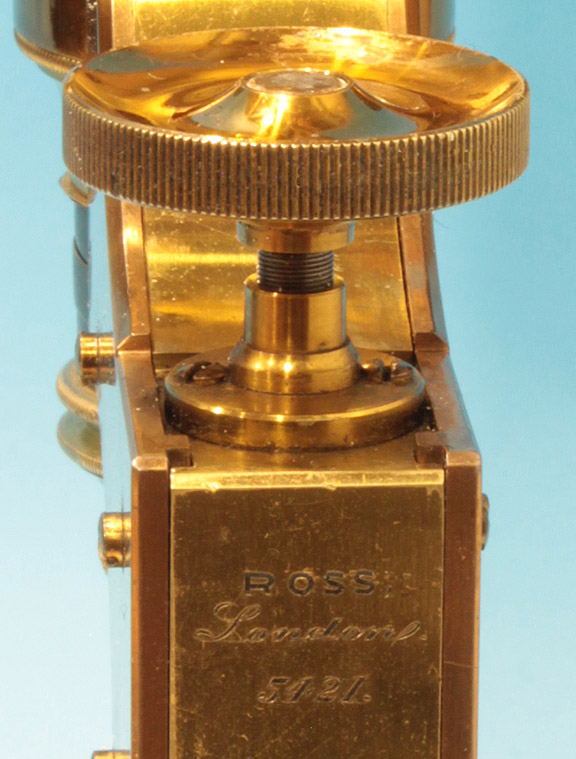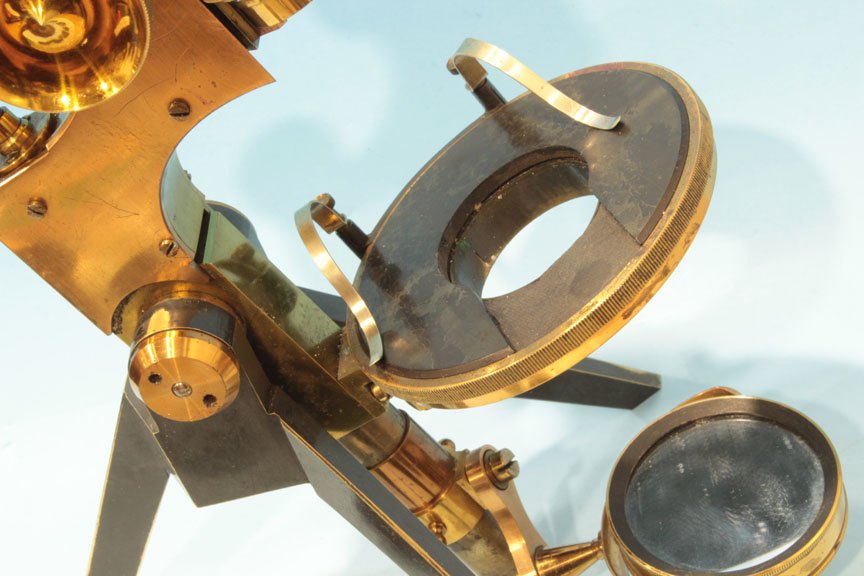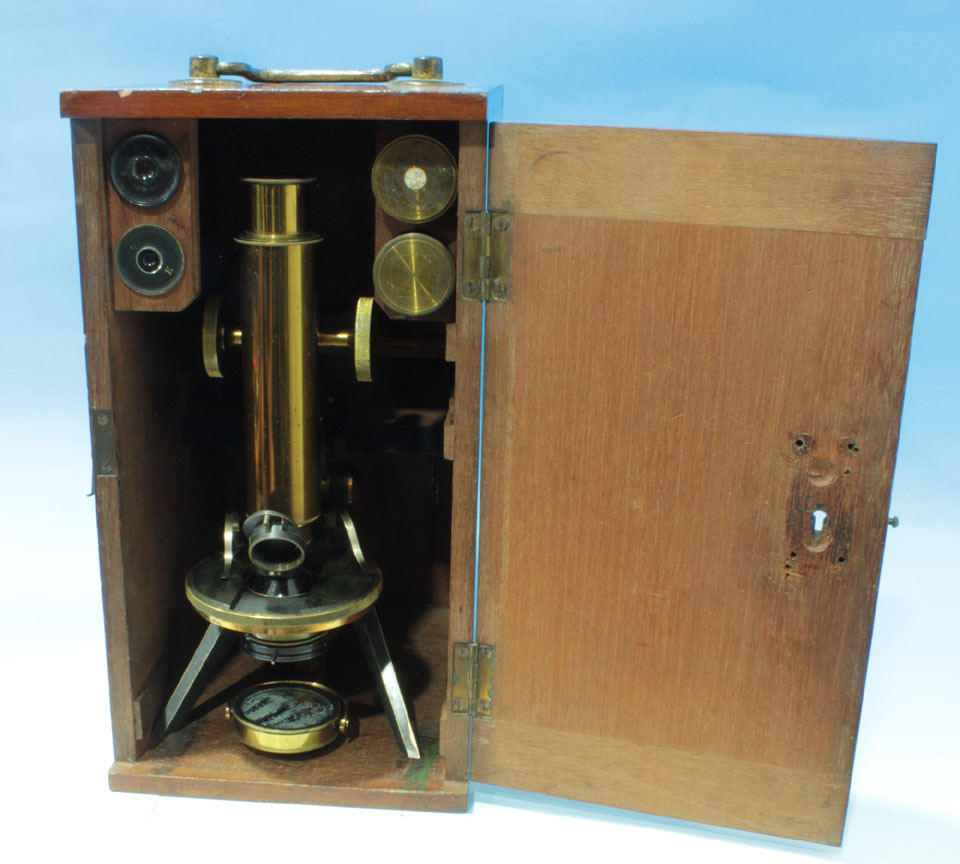ROSS PATENT MICROSCOPE
c. 1885
SIGNED ON THE BACK OF THE LIMB: ROSS, London, 5421
SERIAL NUMBER: 5421
MODEL:No 4 STUDENT'S TRIPOD STAND
Authors: Barry Sobel and Jurriaan de Groot
Editor: Joseph Zeligs
Please Click On Any Picture for a
Larger Version
DESCRIPTION:
 . This is a fine example of the Ross No 4 Student's Tripod Stand. It is signed on the back of the limb: ROSS, London, 5421. It is built on a tripod with a trunion inclination joint. The microscope can be inclined from vertical to to horizontal, or any position in between. The limb registers on the tripod serving as a stop for the horizontal position. The Lister-Jackson limb supports a monocular optical tube with draw tube. The tube accepts Continental size (23 mm diameter) eyepieces. Coarse focusing adjustment is by diagonal rack and spiral pinion. The fine adjustment is via long lever within the limb controlled at the rear by a knurled fine focus knob.
. This is a fine example of the Ross No 4 Student's Tripod Stand. It is signed on the back of the limb: ROSS, London, 5421. It is built on a tripod with a trunion inclination joint. The microscope can be inclined from vertical to to horizontal, or any position in between. The limb registers on the tripod serving as a stop for the horizontal position. The Lister-Jackson limb supports a monocular optical tube with draw tube. The tube accepts Continental size (23 mm diameter) eyepieces. Coarse focusing adjustment is by diagonal rack and spiral pinion. The fine adjustment is via long lever within the limb controlled at the rear by a knurled fine focus knob.
 The stage has a hard rubber surface covering* and can be easily rotated by hand, its edge being knurled. The two brass stage clips are removeable. A sleeve attached to the bottom of the stage accepts substage accessories such as the wheel of apertures or the Abbe-type condenser. The tailpiece carries a mirror on a sliding mount to which the mirror is attached via an articulated extension. The mirror is plane on one side and concave on the other. There is a double nosepiece.
The stage has a hard rubber surface covering* and can be easily rotated by hand, its edge being knurled. The two brass stage clips are removeable. A sleeve attached to the bottom of the stage accepts substage accessories such as the wheel of apertures or the Abbe-type condenser. The tailpiece carries a mirror on a sliding mount to which the mirror is attached via an articulated extension. The mirror is plane on one side and concave on the other. There is a double nosepiece.

The microscope came in its original mahogany dovetailed case. Inside the case there are two fittings on each side, the left side holding two continental eyepieces, and the right side holding two microscope objective cans. A previous owner aded a plywood fitting in the rear to hold one of the condensers and the two additional eyepieces.
OPTIONAL FEATURES OF THE STUDENT TRIPOD No 4:
Two versions of this stand were offered in the 1883 catalog. The only difference was the less expensive one had coarse focus by draw tube instead of rack and pinion.
*The 1883 catalog stated the instrument had a glass-topped stage, but this example, has a hard rubber ebonite stage with a slot cut out. Since serial numbers both higher and lower do have a glass stage top, it is likely this hard rubber stage is a replacement.
ACCESSORIES FOR THE ROSS TRIPOD No 4 MICROSCOPE:
This microscope came with a removeable substage wheel of apertures, an Abbe-type condenser, a double nosepiece, 4 eyepieces and 3 objectives. The objectives are all by Swift and include a 2/3 inch, a 1/6 inch and another unmarked low power objective. The eyepieces are marked 1
, 3
(also scratched as 8x
),E, 4
, and 17mm, X15
.
CONDITION:
Overall this smaller microscope is in excellent condition. There are a few scattered small lacquer losses. The concave mirror is in excellent condition, the plano mirror has considerable spotting but is still functional. The original case is in good condition with the usual cracks from shrinkage as often occurs as the humidity drops. A supplementary fitting, made of plywood, has been added by a previous owner in the back to hold one of the condensers and two eyepieces. The lock is missing from the case which is held closed by a latch on the left side. The brass handle of the case is original but most of the lacquer has worn off.
HISTORY OF ROSS STUDENT TRIPOD NO 4 MICROSCOPE
This microscope was not listed in the 1875 or 1880 catalogs. In the 1883 catalog, which featured mainly various iterations of the Ross-Zentmayer stand, it was offered in two forms differing only in that the less expensive version had sliding coarse focus instead of rack and pinion. It was about the same size as the Ross-Zentmayer No 4 stand. It was listed as having a glass topped stage, so presumably the use of hard rubber was a replacement. By the 1890s advertising by Ross emphasized various sizes of Continental pattern microscopes and their Anglo-continental
stands (which combined a Continental limb with one of the English-originated types of foot). The Ross No 4 was an attempt to provide something like the Watson Fram, already established on the market. Shortly after Ross promoted this microscope and the Ross-Zentmayer models, they belatedly tried to emulate the more popular continental microscopes with models such as the Eclipse, which combined a ring-shaped foot with a Continental limb. They apparently joined this effort too late however, and by 1906 Ross was no longer making microscopes at all.
 . This is a fine example of the Ross No 4 Student's Tripod Stand. It is signed on the back of the limb: ROSS, London, 5421. It is built on a tripod with a trunion inclination joint. The microscope can be inclined from vertical to to horizontal, or any position in between. The limb registers on the tripod serving as a stop for the horizontal position. The Lister-Jackson limb supports a monocular optical tube with draw tube. The tube accepts Continental size (23 mm diameter) eyepieces. Coarse focusing adjustment is by diagonal rack and spiral pinion. The fine adjustment is via long lever within the limb controlled at the rear by a knurled fine focus knob.
. This is a fine example of the Ross No 4 Student's Tripod Stand. It is signed on the back of the limb: ROSS, London, 5421. It is built on a tripod with a trunion inclination joint. The microscope can be inclined from vertical to to horizontal, or any position in between. The limb registers on the tripod serving as a stop for the horizontal position. The Lister-Jackson limb supports a monocular optical tube with draw tube. The tube accepts Continental size (23 mm diameter) eyepieces. Coarse focusing adjustment is by diagonal rack and spiral pinion. The fine adjustment is via long lever within the limb controlled at the rear by a knurled fine focus knob. The stage has a hard rubber surface covering* and can be easily rotated by hand, its edge being knurled. The two brass stage clips are removeable. A sleeve attached to the bottom of the stage accepts substage accessories such as the wheel of apertures or the Abbe-type condenser. The tailpiece carries a mirror on a sliding mount to which the mirror is attached via an articulated extension. The mirror is plane on one side and concave on the other. There is a double nosepiece.
The stage has a hard rubber surface covering* and can be easily rotated by hand, its edge being knurled. The two brass stage clips are removeable. A sleeve attached to the bottom of the stage accepts substage accessories such as the wheel of apertures or the Abbe-type condenser. The tailpiece carries a mirror on a sliding mount to which the mirror is attached via an articulated extension. The mirror is plane on one side and concave on the other. There is a double nosepiece. 